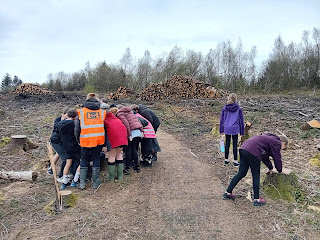Bore da pawb, croeso.
Before I get into this week's blog properly, a reflection on the past week.
 |
| Counting growth rings |
Lost forever or maybe not... The Fen Orchid, Liparis loeselii, highlighted in the publication "The Nature of West Wales" by David Saunders in 1986 referring to Carmarthenshire as "..one of the county's specialities" although not seen Tywyn Burrows since 1971 and Pembrey Burrows since 1930.
Fen Orchid var ovata
Recently rediscovered on the MOD site at Pendine Burrows it would seem to be back in the county
Rare orchid rediscovered on MOD land - GOV.UK (www.gov.uk)
Fen orchid Liparis loeselii is a small green-flowered orchid of fens and dune systems. Two morphologically distinct forms occur: the type form of the East Anglian fens has acute oblong-elliptical leaves, while the form occurring in the dune slacks of south Wales and formerly north Devon (var. ovata) is shorter, generally fewer-flowered and bears blunt, broadly elliptical leaves. In the UK the two forms are mutually exclusive with respect to their distribution between habitats, but in mainland Europe the type (fenland) form var. loeselii also occurs in dune slacks.
The major factors leading to its widespread decline have been habitat loss and deterioration.
All fenland sites in the Norfolk Broads are subject to high water tables throughout the year and some experience winter flooding. The cessation of peat-cutting in the fens is probably the most important contributory factor leading to the decline of this species, as L. loeselii in this area is confined to tall-herb fens that have experienced disturbance through peat-cutting.
In dune slacks L. loeselii occurs across quite a wide range of vegetation types, though principally in younger dune slack communities where some open soil remains. These dune slacks are all subject to winter flooding, with inundation often occurring for up to five months in a year. A high summer water table appears to be essential for the survival of this drought-sensitive species. In common with many other orchids, the fen orchid appears to rely on regular disturbance for its long-term survival at any one site, and dune system over-stabilisation has been a major causal element in its decline.
I have been unable to track down the exact location on Pembrey Burrows for the pre 1930 records but maybe just maybe a search of likely habitats, and there are a few may reveal the presence of this diminutive orchid.




No comments:
Post a Comment